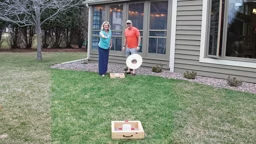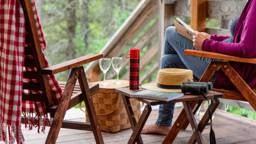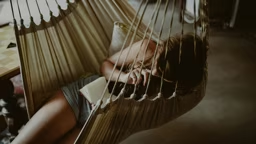Spring has finally sprung and you can’t wait to hit the cabin for some R & R. But a great way to get some exercise while relaxing is by getting outside and riding a bicycle.

Cycling is gentler on your knees, hips and other joints than running or vigorous hiking, and like those activities, it gets you out in nature where you can explore the great outdoors with all your senses. Feel the wind caress your skin, inhale the deep pine forest aroma, hear the distant cry of a raptor on the wing.
Plus, it’s fun. It’s hard to pedal a bicycle in cabin country and not feel like a 10-year-old enjoying the joy and freedom of another endless summer.
On the practical side, cycling is terrific transportation for short trips. Bike into town for some simple shopping or visit the ice cream parlor for one of those triple-dip, mint chocolate chip ice cream cones. Yum! (Or a small frozen yogurt; it’s all good.) And of course, pedaling a bike for short trips saves gas and removes the hassle of hunting for parking.
But, with so many types of bikes to choose from, how do you know which one is best for you?
Perhaps the two biggest considerations are 1) the terrain where you’ll be riding – is it flat or hilly, paved or unpaved, etc., and 2) what you intend to use the bike for – leisurely jaunts with the kids to a nearby beach, hard-core trail and gravel-road exploration, or something in between? (Your physical fitness level is a huge consideration as well, but for the purposes of this story, we’ll assume you’re fit enough to ride at least at the casual level.)
 Mountain Bike - Suspension is a big plus.
Mountain Bike - Suspension is a big plus.
Mountain bikes come with a wide gear range to help you pedal up even the biggest hills, and suspension systems (i.e., shock absorbers) to soak up bumps in the road and trail. Plus, their fat knobby tires are built specifically to withstand pothole-riddled gravel roads, rock- and root-strewn trails, and pretty much anything you’re likely to come across. They offer a more upright riding position than road bikes, which contributes to added comfort. Most mountain bikes come with disc brakes too. These offer superior stopping power, especially helpful in wet conditions.
On the downside, mountain bikes can be heavy, and if you plan on riding on pavement at all, the increased rolling resistance of their wide tires can sometimes make you feel like you’re not getting anywhere. Personally, I like to ride dirt trails and gravel roads, but often have to pedal paved roads to get to them. So, I’ve installed lighter, narrower tires – 1.7 inches wide instead of say, 2.3 or wider – with a less aggressive tread that greatly improves rolling resistance.
Expect to pay $500 or more for a mountain bike.
 Recreational Bike - A great, can’t-miss cabin bike and a good choice for a guest bike.
Recreational Bike - A great, can’t-miss cabin bike and a good choice for a guest bike.
In terms of versatility, comfort, cost, ease of use, and just pure fun, recreational bikes are the way to go for tooling around during your cabin stay. Sometimes called hybrid or comfort bikes, these combine the best features of road and mountain bikes. They offer an upright, comfortable position and a wide gear range like a mountain bike, but boast a lighter frame and have narrower (but not super-skinny) tires.
They often come with a simple suspension fork and/or a shock-absorbing seat post for smoothing out the minor bumps on rough roads.
Recreational bikes are great for shopping too because their wide handlebars easily accommodate a basket; most can take rear racks and panniers too, which further increases carrying capacity. (For more on panniers, see sidebar below.)
Because recreational bikes are not super expensive (prices start at about $350), they are a great choice if you want to have an extra bike or two around the cabin for guests. A word about guest bikes: Be sure to buy a bike with a quick-release seat post to make height adjustments quick and easy.
 Beach Cruiser - A fun bike for short, flat routes and a good guest bike.
Beach Cruiser - A fun bike for short, flat routes and a good guest bike.
With their fat tires, upright position and wide, basket-ready handlebars, these ultra-comfy bikes make an excellent choice for riding short distances on mostly flat roads and pathways. With no gears and boasting coaster brakes – just pedal backward if you want to stop – cruisers are the easiest to ride.
Because of that lack of gears, however – along with the fact that they tend to be heavy – cruisers are not practical for long distances or hilly terrain.
Like recreational bikes, these are relatively inexpensive ($200 and up) and their ease of use makes them terrific guest bikes.

Folding Bike
Folding Bike - Packs up small and a good guest bike.
Exactly like they sound, these bikes fold up for easy storage and transport. Their wheels are smaller than regular bikes – usually 20 inches versus 26 or 27 – but they don’t compromise when it comes to features including gears, suspension forks and even disc brakes.
It’s another good choice for a guest bike because you can stow it away until you need it. Prices start at about $600.
E-Bike - Power assist
No, this isn’t cyber-biking on the Internet. The electric-assist bike is a relatively new cycling option which uses an electric motor in the rear-hub to assist your pedaling. Not to get too technical about it, but when a rider pedals, the motor’s torque sensor measures the pedaling power and then multiplies it depending on the desired setting. Most e-bikes are configured like a recreational bike and thus are great for carrying loads.
Admittedly, e-bikes aren’t cheap ($1,000 and up) or light (a hefty 50–70 pounds), but they make a fascinating option for a wide range of terrains.

E-Bike
Road Bike - Not for everyone
These are the bikes you see in the Tour de France. Unless your cabin is located on a paved road, forget road bikes. They’re lightweight, fast and fun to ride, but not super comfortable, can be expensive, and aren’t very versatile. Their slick, skinny tires and ultralight frames aren’t made for anything but smooth pavement and speed.
Things to Take Along on Your Ride
Before you head out for some two-wheeled exploration, here’s one piece of must- have gear as well as suggestions for items that will make your riding more enjoyable.
Essential
• Helmet.
Prices start at about $30. Major brands include Bell, Giro, Louis Garneau, Cannondale and Nutcase.
Things that arenice to have
• Padded shorts
• Cycling gloves
• Jersey with rear pockets
Things to take on longer rides
• Water bottle
• Snacks
• Spare tube or patch kit
• Mini-pump
• Multi-tool
• Seat bag to carry tube, pump, tools and other small items
• Sunscreen (or apply before you head out)
• Map
• Cell phone
To carry your gear on longer rides, or to carry your loot home from the grocery store, buy a pair of panniers. Today’s models are easy to use; the ones shown here from Trek click right onto your bike rack. No straps or bungees are needed.
Happy riding!
Mike McQuaide is a bicycle-crazed freelance writer and author. His latest book is “75 Classic Rides: Washington” (Mountaineers Books).
 Cycling is gentler on your knees, hips and other joints than running or vigorous hiking, and like those activities, it gets you out in nature where you can explore the great outdoors with all your senses. Feel the wind caress your skin, inhale the deep pine forest aroma, hear the distant cry of a raptor on the wing.
Plus, it’s fun. It’s hard to pedal a bicycle in cabin country and not feel like a 10-year-old enjoying the joy and freedom of another endless summer.
On the practical side, cycling is terrific transportation for short trips. Bike into town for some simple shopping or visit the ice cream parlor for one of those triple-dip, mint chocolate chip ice cream cones. Yum! (Or a small frozen yogurt; it’s all good.) And of course, pedaling a bike for short trips saves gas and removes the hassle of hunting for parking.
But, with so many types of bikes to choose from, how do you know which one is best for you?
Perhaps the two biggest considerations are 1) the terrain where you’ll be riding – is it flat or hilly, paved or unpaved, etc., and 2) what you intend to use the bike for – leisurely jaunts with the kids to a nearby beach, hard-core trail and gravel-road exploration, or something in between? (Your physical fitness level is a huge consideration as well, but for the purposes of this story, we’ll assume you’re fit enough to ride at least at the casual level.)
Cycling is gentler on your knees, hips and other joints than running or vigorous hiking, and like those activities, it gets you out in nature where you can explore the great outdoors with all your senses. Feel the wind caress your skin, inhale the deep pine forest aroma, hear the distant cry of a raptor on the wing.
Plus, it’s fun. It’s hard to pedal a bicycle in cabin country and not feel like a 10-year-old enjoying the joy and freedom of another endless summer.
On the practical side, cycling is terrific transportation for short trips. Bike into town for some simple shopping or visit the ice cream parlor for one of those triple-dip, mint chocolate chip ice cream cones. Yum! (Or a small frozen yogurt; it’s all good.) And of course, pedaling a bike for short trips saves gas and removes the hassle of hunting for parking.
But, with so many types of bikes to choose from, how do you know which one is best for you?
Perhaps the two biggest considerations are 1) the terrain where you’ll be riding – is it flat or hilly, paved or unpaved, etc., and 2) what you intend to use the bike for – leisurely jaunts with the kids to a nearby beach, hard-core trail and gravel-road exploration, or something in between? (Your physical fitness level is a huge consideration as well, but for the purposes of this story, we’ll assume you’re fit enough to ride at least at the casual level.)




 Recreational Bike - A great, can’t-miss cabin bike and a good choice for a guest bike.
Recreational Bike - A great, can’t-miss cabin bike and a good choice for a guest bike.









